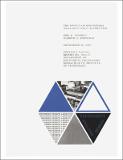The effect of nonuniform axial heat flux distribution on the critical heat flux
Author(s)
Todreas, Neil E.; Rohsenow, Warren M.
DownloadHTL_TR_1965_037.pdf (13.22Mb)
Other Contributors
Massachusetts Institute of Technology. Dept. of Mechanical Engineering.
Massachusetts Institute of Technology. Heat Transfer Laboratory.
Metadata
Show full item recordAbstract
A systematic experimental and analytic investigation of the effect of nonuniform axial heat flux distribution on critical heat rilux was performed with water in the quality condition. Utilizing a model which ascribes the critical condition, to either a nucleation-induced disruption of the annular liquid film or annular film dryout, the experimental results taken at low pressures (50-200 psia) were confirmed. Application of this model to higher pressure conditions (500-2000 psia) indicated qualitative agreement with available data of other investigators. Experimental data was obtained for flux distributions representing cosine, linear increasing and decreasing, inlet and exit peaked, spike and uniform shapes. These flux distributions were achieved by electrical resistance heating of test sections whose outside diameter had been machined to the required dimensions.. In each case the critical location as well as the total critical power was obtained by testing the tubes in vertical upflow to failure. The analytic prediction of the results for all flux shapes has been achieved by development of a model which considers the effect of nucleation within the annular film. It is thown that the occurrence of the critical condition is related to the local degree of nucleation (the ratio of the local flux to the flux required to cause nucleation at the local conditions) and the local film flow rate. Both the experimental total critical power and the critical location are confirmed by this model. The results indicate that the total critical power for the outlet peaked flux distributions tested (ratios of maximum to minimum flux of 2, 4, and 5.75 to 1) can be 15 to 30% lower than for uniform flux distributions at comparable hydrodynamic operating conditions. (cont.) In addition, from this model for given operating conditions, a locus of critical conditions can be constructed from uniform flux distribution data which will enable prediction of the performance of nonuniform flux distributions at similar conditions of mass velocity, pressure and diameter.
Date issued
1965Publisher
Cambridge, Mass. : M.I.T. Dept. of Mechanical Engineering, [1965]
Other identifiers
14088571
Series/Report no.
Technical report (Massachusetts Institute of Technology, Heat Transfer Laboratory) ; no. 37.
Keywords
Heat -- Transmission., Heat -- Convection., Boiling water reactors., Pressurized water reactors.